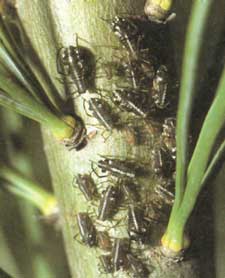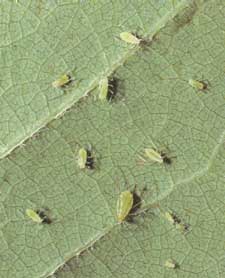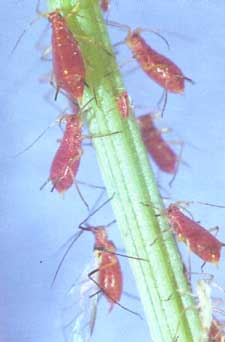AphidsMichael D. Connor - Entomologist, Region 8, USDA Forest Service, Pineville, LA, and Cordell C.E., Anderson R.L., Hoffard W.H., Landis T.D., Smith R.S. Jr., Toko H.V., 1989. Forest Nursery Pests. USDA Forest Service, Agriculture Handbook No. 680, 184 pp. Hosts Seedlings of all tree species are subject to attack by one or more species of aphids. Species of the genus Cinara, which attack conifers, are probably the most important of the seedling-infesting aphids. Distribution Aphids occur throughout North America. There are approximately 1,380 species in 277 genera, but relatively few feed on trees. Damage Aphids feed on plant sap, causing a general weakening in the area of feeding. Heavy feeding may result in branch dieback or the death of seedlings. Aphids may also spread pathogenic viruses during feeding. When this occurs, damage to plants can be substantial. Diagnosis Aphids attack all types of seedling tissues (roots, stems, and foliage). Look for symptoms such as yellowing of foliage, curling of leaves, branch deformities, and galls.
Aphids are usually exposed while feeding, but 5ome cover themselves with a waxy material, and others feed inside galls. Biology Since there are so many species of aphids, only a general description can be given of their life cycles. Winged females lay eggs. The eggs hatch, and nymphs mature into wingless adults. These wingless forms reproduce without mating, and the females usually bear live young. After several generations, winged females are produced. These winged females migrate to a new host, and wingless females are again produced. After several more generations, males and females are produced. They mate, the females lay eggs, and the cycle is repeated. Some species of aphids have a more complicated life cycle and migrate between a primary and secondary host. Environmental conditions strongly affect aphid populations. Fungus-caused diseases, parasitic wasps, and predators like lady beetles, lacewings, nabid bugs, and syrphid fly larvae provide some natural control. However, when environmental conditions are favorable for the aphid population, biological agents cannot keep populations in check. This is especially true in nurseries, where susceptible host plants are concentrated in a small area. Control Cultural - Maintain seedling vigor through proper fertilization and irrigation to increase tolerance to aphids. Chemical - Use registered insecticides, such as dimethoate and malathion, to effectively control aphids. Apply sprays to the point of runoff on all foliage and stem surfaces. Read and follow label directions carefully to prevent seedling injury. Selected References Anderson, 1960. Forest and shade tree entomology. New York: John Wiley & Sons: 347-351. Johnson, N.E. 1965. Reduced growth associated with infestations of Douglas-fir seedlings by Cinara species (Homoptera: Aphidae). Canadian Entomologist. 97(2): 113-119. Johnson, Warren T.; Lyon, Howard H. 1976. Insects that feed on trees and shrubs. Ithaca. NY: Cornell University Press: 68-69, 248-271. Smith. CF.; Parron, C.S. 1978. An annotated list of aphididae (Homoptera) of North America. Tech. Bull. 255. Raleigh. NC: North Carolina Agricultural Experiment Station. 428 p. |
Forest Pests: Insects, Diseases & Other Damage Agents |

|
|




